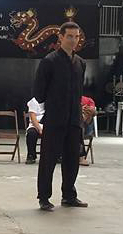Some people see the Master
As one who knows everything
Which remains on a pedestal
Untouchable, Unreachable
But I discovered something different
The Master is not the one that makes distant
But he who
Down to earth
You are placed so close to his disciples
you can see the weaknesses in them,
But looks beyond
the force that each have.
The true Master
Can you understand that each student
It has a different way of learning
And strives to teach different.
Being able to
in a week to make a whole Kati
the student can do
The Master is one
Who knows ponder times
To get angry, extremely angry
Very brave and those special days
it is best to avoid talking with him
Forcing his students to go beyond
Beyond the limits that were credible
But also sustains, comforts
Cares and respects
Those who are on your side
And as much as will wish
be constantly close
The Master knows that you can not
Forever protect his disciples
Then teach
The find their way,
to walk alone
The prepares
To kindle the flame
Aiming to depart darkness
Whilst this is internal
This is the concept we now have
When I think
The meaning of a true Master
In a specific Master
I chose to follow
Masters because few would be able to say
"What if one day is not as good as would be enough
His disciples are!
Since it does not give up "
This is (our) Shi reng Louis
The Shi reng Louis
And probably
The bravest person
I know
The lack of fear it
Makes
sometimes it seems unwise
But it is evident
He trusts and knows
strength which has
Humility and Character
They are probably
the strongest points of it
And in contrast with the force
it keeps immense purity of heart
Being able to host
and guide
Who has sincere interest
To be with him
This is the Shi reng Louis
Who was born with the Sun
To guide,
the students teach
That the hands of Destiny
We were fortunate to know
And this ceremony choose
Says one proverb that
"When the pupil is ready the Master appears"
Maybe that's why
Each of the four of us
Let us be known at various times
And although we have such different stories
We met and got to the same place
So here we are,
Before whom choose
and stand before you Shi reng,
Requesting that accepts us
with a promise to be loyal
Kung Fu and our Master
We promise to respect and follow
To recognize and defend
Its principles as our
Recognizing the way
Like that
we want the track
Maybe "some" can not promise
Do not get into confusion
But we do promise
We commit
Be benevolent
Persevering and patient
We promise to always seek progress
So we can
As disciples proud of you
* Text written by students in Homage to the Master Louis, to perform the tea ceremony.
Pou San Chuan
Martial Arts Academy
São José do Rio Preto - SP
Brazil















